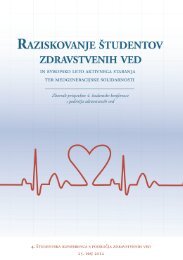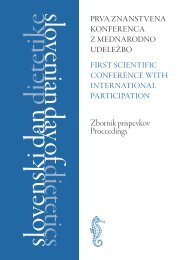Service quality measurement in Croatian wellness tourism: An ...
Service quality measurement in Croatian wellness tourism: An ...
Service quality measurement in Croatian wellness tourism: An ...
You also want an ePaper? Increase the reach of your titles
YUMPU automatically turns print PDFs into web optimized ePapers that Google loves.
Academica Turistica<br />
Discussions<br />
<strong>Service</strong> <strong>quality</strong> <strong>measurement</strong> <strong>in</strong><br />
<strong>Croatian</strong> <strong>wellness</strong> <strong>tourism</strong>:<br />
<strong>An</strong> application of the SERVQUAL scale<br />
Suzana Marković<br />
University of Rijeka<br />
Faculty of Tourism and Hospitality Management, Opatija, Croatia<br />
Suzana.Markovic@fthm.hr<br />
Sanja Raspor<br />
Polytechnic of Rijeka, Croatia<br />
sraspor@veleri.hr<br />
Jelena Komšić<br />
University of Rijeka<br />
Faculty of Tourism and Hospitality Management, Opatija, Croatia<br />
jkomsic@fthm.hr<br />
Abstract<br />
The purpose of this study is to contribute to the conceptual and empirical knowledge of service <strong>quality</strong> <strong>in</strong> <strong>wellness</strong><br />
sett<strong>in</strong>gs. The aim is to provide a theoretical background of the ma<strong>in</strong> concepts of <strong>in</strong>terest and to empirically<br />
assess customer expectations and perceptions, as well as to determ<strong>in</strong>e the overall <strong>quality</strong> of <strong>wellness</strong> services.<br />
Data were collected us<strong>in</strong>g a self-adm<strong>in</strong>istered questionnaire, based on the dimensions of the SERVQUAL scale<br />
(Parasuraman, Zeithaml & Berry, 1988). The questionnaire was divided <strong>in</strong>to three parts. First, the respondents’<br />
expectations regard<strong>in</strong>g service <strong>quality</strong> <strong>in</strong> <strong>wellness</strong> sett<strong>in</strong>gs <strong>in</strong> general were measured. The second part exam<strong>in</strong>ed<br />
the respondents’ perceptions of service <strong>quality</strong> <strong>in</strong> <strong>wellness</strong> centers <strong>in</strong> <strong>Croatian</strong> hotels. The third part of the<br />
questionnaire consisted of demographic questions. Factor analysis and reliability analysis were conducted to<br />
identify key factors of <strong>wellness</strong> service <strong>quality</strong> and to test the reliability and consistency of the <strong>measurement</strong> scale.<br />
The results revealed high customer expectations and perceptions of <strong>wellness</strong> service <strong>quality</strong>. Moreover, three<br />
factors were identified that best expla<strong>in</strong>ed expected <strong>wellness</strong> service <strong>quality</strong> and all were highly reliable. On<br />
the other hand, two highly reliable factors were identified regard<strong>in</strong>g the perceived <strong>quality</strong> of <strong>wellness</strong> services.<br />
Keywords: service <strong>quality</strong>, SERVQUAL, statistical analysis, <strong>wellness</strong> <strong>tourism</strong>, Croatia<br />
Academica Turistica, Year 5, No. 1, June 2012 | 47
Suzana Marković, Sanja Raspor, Jelena Komšić<br />
<strong>Service</strong> <strong>quality</strong> <strong>measurement</strong> <strong>in</strong> <strong>Croatian</strong> ...<br />
1 Introduction<br />
Over recent years, the health <strong>tourism</strong> sector has spread<br />
its framework from a solely curative purpose to a variety<br />
of preventive programs, known as <strong>wellness</strong> services.<br />
This relatively new concept <strong>in</strong> the <strong>tourism</strong> segment is<br />
immanent <strong>in</strong> practice. However, despite its emerg<strong>in</strong>g<br />
popularity, it lacks a clear and widely understood<br />
def<strong>in</strong>ition, standard classifications or complete, up-to<br />
date market <strong>in</strong>formation.<br />
Wellness is a complex and multidiscipl<strong>in</strong>ary concept.<br />
The term is a comb<strong>in</strong>ation of the words “well-be<strong>in</strong>g”<br />
and “fitness” and was developed by the American<br />
physician Halbert Dunn <strong>in</strong> 1959. Wellness is a special<br />
state of health compris<strong>in</strong>g an overall sense of well-be<strong>in</strong>g<br />
and sees a person as a comb<strong>in</strong>ation of body, spirit and<br />
m<strong>in</strong>d (Dunn, 1959). Myers, Sweeney and Witmer (2005)<br />
def<strong>in</strong>ed <strong>wellness</strong> as a way of life oriented towards optimal<br />
health and well-be<strong>in</strong>g, <strong>in</strong>tegrat<strong>in</strong>g body, m<strong>in</strong>d<br />
and spirit. These def<strong>in</strong>itions imply that <strong>wellness</strong> is a<br />
holistic philosophy, and it can be viewed as a way of life.<br />
Accord<strong>in</strong>g to Müller and Lanz Kaufmann (2001), the<br />
pr<strong>in</strong>cipal elements of <strong>wellness</strong> are self-responsibility,<br />
physical fitness/beauty care, healthy nutrition, relaxation,<br />
mental activity/education and environmental<br />
sensitivity/social contacts.<br />
Generally, <strong>wellness</strong> <strong>tourism</strong> is classified as a subcategory<br />
of health <strong>tourism</strong>. Although the terms are<br />
related, they differ <strong>in</strong> their applications and target<br />
groups, and should be viewed as different <strong>tourism</strong><br />
segments. Wellness <strong>tourism</strong> is the sum of all the relationships<br />
and phenomena result<strong>in</strong>g from a journey and<br />
residence by people whose ma<strong>in</strong> motive is to preserve<br />
or promote their health. They stay <strong>in</strong> a specialized hotel<br />
that provides the appropriate professional know-how<br />
and <strong>in</strong>dividual care. They require a comprehensive<br />
service package compris<strong>in</strong>g physical fitness/beauty<br />
care, healthy nutrition/diet, relaxation/meditation and<br />
mental activity/education (Müller & Lanz Kaufmann,<br />
2001).<br />
Wellness <strong>tourism</strong> has several important advantages<br />
over other <strong>tourism</strong> segments (M<strong>in</strong>tel International<br />
Group, 2004). Essentially, there is no off-season for<br />
<strong>wellness</strong> <strong>tourism</strong>, the average length of stay is longer,<br />
tourist expenditure per day is higher than average, it<br />
provides comprehensive service packages, and it attracts<br />
all age groups. These features are some of the<br />
reasons why many hotels redesign their offer and turn<br />
to <strong>wellness</strong> tourists as a very lucrative segment of the<br />
tourist population.<br />
Given the variety of products and services that are<br />
part of <strong>wellness</strong> <strong>tourism</strong>, it is difficult to develop a<br />
mean<strong>in</strong>gful profile of <strong>wellness</strong> tourists. However, <strong>in</strong><br />
general, <strong>wellness</strong> customers are middle-aged, educated<br />
and hold jobs with higher <strong>in</strong>comes. They are demand<strong>in</strong>g<br />
and expect a high <strong>quality</strong> of services (M<strong>in</strong>tel<br />
International Group, 2004). A recently observed trend<br />
is that the average age of this target group is becom<strong>in</strong>g<br />
younger. Smith and Kelly (2006) stated that the majority<br />
of <strong>wellness</strong> tourists are already active at home<br />
<strong>in</strong> some form of <strong>wellness</strong> activity (yoga, meditation,<br />
massage). Further, the predom<strong>in</strong>ant population is<br />
made up of females who are self-aware and are active<br />
seekers of enhanced well-be<strong>in</strong>g, health and happ<strong>in</strong>ess.<br />
Müller and Lanz Kaufmann (2001) identified four segments<br />
of health and <strong>wellness</strong> customers: demand<strong>in</strong>g<br />
health guests, <strong>in</strong>dependent <strong>in</strong>frastructure users, care<strong>in</strong>tensive<br />
cure guests and undemand<strong>in</strong>g recreation<br />
guests. In this context, the characteristics of health<br />
and <strong>wellness</strong> customers vary from traditional guests<br />
receiv<strong>in</strong>g health treatments, to bus<strong>in</strong>ess people and<br />
conference participants, to young families on holiday<br />
(Snoj & Mumel, 2002).<br />
Accord<strong>in</strong>g to the <strong>Croatian</strong> Chamber of Economy,<br />
there has been a notable growth of the <strong>Croatian</strong> <strong>wellness</strong><br />
<strong>tourism</strong> market <strong>in</strong> the past few years. However,<br />
statistics related to this <strong>tourism</strong> segment are rather<br />
limited. There are 68 hotel sett<strong>in</strong>gs (both <strong>in</strong> the <strong>in</strong>land<br />
and the coastal region) offer<strong>in</strong>g <strong>wellness</strong> programs.<br />
A pilot study of the additional offer<strong>in</strong>g <strong>in</strong><br />
3-, 4- and 5-star hotels was conducted <strong>in</strong> August of<br />
2009 (<strong>Croatian</strong> Chamber of Economy and Horwath<br />
Consult<strong>in</strong>g Zagreb, 2009). Based on the f<strong>in</strong>d<strong>in</strong>gs, the<br />
follow<strong>in</strong>g was concluded: 48,754 guests, spend<strong>in</strong>g<br />
approximately EUR 16 per person, visited hotel <strong>wellness</strong><br />
centers <strong>in</strong> 2008. Average annual <strong>wellness</strong>-related<br />
revenue per hotel was EUR 211,473 and the average<br />
48 | Academica Turistica, Year 5, No. 1, June 2012
Suzana Marković, Sanja Raspor, Jelena Komšić <strong>Service</strong> <strong>quality</strong> <strong>measurement</strong> <strong>in</strong> <strong>Croatian</strong> ...<br />
share of the annual <strong>wellness</strong>-related revenue <strong>in</strong> the<br />
total hotel revenue was 6 per cent. Furthermore, <strong>in</strong><br />
3-star hotels the share of <strong>wellness</strong> customer overnights<br />
accounted for 94 per cent <strong>in</strong> the number of total hotel<br />
overnight stays.<br />
2 <strong>Service</strong> <strong>quality</strong> – concept and<br />
<strong>measurement</strong><br />
2.1 Def<strong>in</strong><strong>in</strong>g <strong>wellness</strong> service <strong>quality</strong><br />
Due to the <strong>in</strong>creased importance of the service sector,<br />
researchers are def<strong>in</strong><strong>in</strong>g <strong>quality</strong> from the customers’<br />
perspective. Among service market<strong>in</strong>g literature,<br />
the most commonly used def<strong>in</strong>ition of service <strong>quality</strong><br />
is to meet customer expectations, as def<strong>in</strong>ed by<br />
Parasuraman et al. (1985). They conceptualized service<br />
<strong>quality</strong> as a form of attitude which results from<br />
a comparison of customer expectations with their<br />
perceptions of service performance.<br />
Expectations are def<strong>in</strong>ed as beliefs about service<br />
process and form the standards aga<strong>in</strong>st which actual<br />
performance will be assessed (Zeithaml & Bitner,<br />
2003). On the other hand, perceived service <strong>quality</strong><br />
is the extent to which a firm successfully serves the<br />
purpose of customers (Zeithaml, Parasuraman &<br />
Berry, 1990).<br />
Customers assess <strong>quality</strong> based on a number of factors.<br />
Leht<strong>in</strong>en and Leht<strong>in</strong>en (1982) def<strong>in</strong>ed three dimensions<br />
of service <strong>quality</strong>, namely, physical <strong>quality</strong>,<br />
<strong>in</strong>teractive <strong>quality</strong> and corporate <strong>quality</strong>. Similarly,<br />
Grönroos (1984) argued that service <strong>quality</strong> comprises<br />
technical <strong>quality</strong>, functional <strong>quality</strong> and corporate<br />
image. Parasuraman et al. (1988) stated that service<br />
<strong>quality</strong> <strong>in</strong>cludes five major dimensions: tangibles,<br />
reliability, responsiveness, assurance and empathy.<br />
Wellness service <strong>quality</strong> attributes are usually def<strong>in</strong>ed<br />
by <strong>in</strong>ternational and national <strong>wellness</strong> associations.<br />
The International Spa Association (ISPA) has<br />
proposed the follow<strong>in</strong>g service <strong>quality</strong> standards:<br />
professional employees, safety and security, customer<br />
relations, service performance and ethics. Similarly,<br />
the German Wellness Federation (Deutscher Wellness<br />
Verband - DWV) has developed standards which relate<br />
to the atmosphere of well-be<strong>in</strong>g and <strong>wellness</strong> ambience,<br />
cleanl<strong>in</strong>ess and security, facilities and programs,<br />
customer-oriented services, friendl<strong>in</strong>ess and <strong>in</strong>formation,<br />
and price-performance ratio.<br />
Accord<strong>in</strong>g to Müller and Lanz Kaufmann (2001), a<br />
prerequisite for comprehensive <strong>wellness</strong> <strong>quality</strong> are<br />
<strong>wellness</strong> <strong>in</strong>frastructure, correspond<strong>in</strong>g services and<br />
qualified staff. These basic requirements <strong>in</strong>clude a<br />
variety of relaxation and physical activities, as well as<br />
the presence of <strong>wellness</strong> professionals who will provide<br />
<strong>in</strong>dividual care and advice.<br />
It can be concluded that service <strong>quality</strong> <strong>in</strong> <strong>wellness</strong><br />
sett<strong>in</strong>gs depends on both tangible and <strong>in</strong>tangible attributes<br />
that are part of the overall <strong>wellness</strong> experience.<br />
2.2 <strong>Service</strong> <strong>quality</strong> <strong>measurement</strong> <strong>in</strong><br />
health and <strong>wellness</strong> <strong>tourism</strong><br />
Measur<strong>in</strong>g service <strong>quality</strong> is difficult due to the <strong>in</strong>tangible,<br />
heterogenic, <strong>in</strong>separable and perishable nature of<br />
services. In order to provide a quantifiable measure of<br />
service <strong>quality</strong> that embraces all the characteristics of<br />
services, Parasuraman et al. (1985; 1988) developed a<br />
<strong>measurement</strong> <strong>in</strong>strument called the SERVQUAL scale.<br />
The SERVQUAL is a multi-item scale for quantify<strong>in</strong>g<br />
the service expectation-perception gap. It is divided<br />
<strong>in</strong>to two parts, each conta<strong>in</strong><strong>in</strong>g 22 items. The first part<br />
is designed to measure the level of expected service,<br />
while the second part measures the level of actual<br />
service as perceived by the customer. The expected and<br />
perceived levels of service <strong>quality</strong> are assessed us<strong>in</strong>g<br />
the Likert-type scale.<br />
Accord<strong>in</strong>g to Parasuraman et al. (1991) SERVQUAL<br />
is a generic <strong>in</strong>strument with good reliability and<br />
validity and broad applicability. In accordance with<br />
this view, the <strong>in</strong>strument has been used to measure<br />
service <strong>quality</strong> <strong>in</strong> a variety of service <strong>in</strong>dustries and<br />
has also been applied <strong>in</strong> several countries (Ladhari,<br />
2008; 2009).<br />
Despite its wide usage, the scale has been criticized<br />
by a number of academics (Carman, 1990; Babakus &<br />
Academica Turistica, Year 5, No. 1, June 2012 | 49
Suzana Marković, Sanja Raspor, Jelena Komšić<br />
<strong>Service</strong> <strong>quality</strong> <strong>measurement</strong> <strong>in</strong> <strong>Croatian</strong> ...<br />
Boller, 1992; Teas, 1994). Criticism was regard<strong>in</strong>g the<br />
conceptual and operational base of the model, mostly<br />
its validity, reliability, operationalization of expectations,<br />
and dimensional structure. However, there is<br />
general agreement that SERVQUAL items are reliable<br />
predictors of overall service <strong>quality</strong> (Khan, 2003).<br />
Consequently, many researchers have modified the<br />
scale to fit the features of a specific service. In the<br />
<strong>tourism</strong> and hospitality <strong>in</strong>dustry, Knutson, Stevens,<br />
Wullaert and Patton (1991) developed LODGSERV,<br />
a model utilized to measure service <strong>quality</strong> <strong>in</strong> the<br />
lodg<strong>in</strong>g <strong>in</strong>dustry. Getty and Thompson (1994) <strong>in</strong>troduced<br />
another specific model for hotel sett<strong>in</strong>gs,<br />
called LODGQUAL, as did Wong Ooi Mei, Dean<br />
and White (1999) who developed a HOLSERV model.<br />
Furthermore, DINESERV is a model used for measur<strong>in</strong>g<br />
restaurant service <strong>quality</strong> (Stevens, Knutson<br />
& Patton, 1995). O’Neill, Williams, MacCarthy and<br />
Grovers (2000) developed the DIVEPERF model<br />
for assess<strong>in</strong>g perceptions of div<strong>in</strong>g services, while<br />
Frochot and Hughes (2000) measured service <strong>quality</strong><br />
<strong>in</strong> historic houses us<strong>in</strong>g HISTOQUAL. ECOSERV<br />
was <strong>in</strong>troduced by Khan (2003) and was utilized to<br />
measure service <strong>quality</strong> expectations <strong>in</strong> eco-<strong>tourism</strong>.<br />
All of these models represent modifications of the<br />
SERVQUAL <strong>in</strong>strument, aim<strong>in</strong>g to improve its orig<strong>in</strong>al<br />
methodology.<br />
Moreover, Cron<strong>in</strong> and Taylor (1992) developed a performance-only<br />
scale called SERVPERF and tested it <strong>in</strong><br />
four <strong>in</strong>dustries. The results <strong>in</strong>dicated that SERVPERF<br />
scale has better psychometric characteristics than<br />
SERVQUAL. This approach was used to measure customer<br />
perceptions of service <strong>quality</strong> <strong>in</strong> hotel sett<strong>in</strong>gs<br />
as well (Choi & Chu, 2001; Juwaheer, 2004; Poon &<br />
Lock-Teng Low, 2005).<br />
Empirical studies related to service <strong>quality</strong> <strong>measurement</strong><br />
<strong>in</strong> health and <strong>wellness</strong> <strong>tourism</strong> sector are rare.<br />
Snoj and Mumel (2002) measured perceived service<br />
<strong>quality</strong> <strong>in</strong> Slovenian health spas. Marković, Horvat<br />
and Raspor (2004) <strong>in</strong>vestigated the service <strong>quality</strong> expectations<br />
and perceptions <strong>in</strong> <strong>Croatian</strong> health <strong>tourism</strong>.<br />
Alén González, Comesana and Brea (2007) assessed<br />
perceived <strong>quality</strong> <strong>in</strong> Spanish spa resorts.<br />
3 Study objectives and<br />
methodology<br />
The ma<strong>in</strong> objective of the study was to empirically<br />
assess <strong>wellness</strong> customer expectations and perceptions,<br />
as well as to determ<strong>in</strong>e overall <strong>wellness</strong> service<br />
<strong>quality</strong>. Moreover, the objective was to determ<strong>in</strong>e the<br />
significance of difference between perceived and expected<br />
service <strong>quality</strong> <strong>in</strong> <strong>wellness</strong> sett<strong>in</strong>gs. F<strong>in</strong>ally, the<br />
study attempted to identify what factors best expla<strong>in</strong><br />
customer expectations and perceptions regard<strong>in</strong>g<br />
<strong>wellness</strong> service <strong>quality</strong>.<br />
Data were collected us<strong>in</strong>g a self-adm<strong>in</strong>istered questionnaire.<br />
The questionnaire was developed based on<br />
dimensions of the SERVQUAL scale (Parasuraman<br />
et al., 1988) and was adapted to the specific features<br />
of a hotel <strong>wellness</strong> center. Despite several criticism<br />
of the SERVQUAL scale (as discussed previously<br />
<strong>in</strong> the literature review), it has been demonstrated<br />
that the <strong>in</strong>strument is useful for diagnostic purposes<br />
(Parasuraman et al., 1991). Therefore, it is justified to<br />
employ the <strong>in</strong>strument <strong>in</strong> this study.<br />
The level of expected and perceived <strong>wellness</strong> service<br />
<strong>quality</strong> was measured on the basis of 17 attributes.<br />
The selected attributes were modified accord<strong>in</strong>g to the<br />
previous studies conducted <strong>in</strong> the hospitality <strong>in</strong>dustry<br />
(Marković, 2003) and <strong>in</strong> the health spa <strong>tourism</strong> sector<br />
(Snoj & Ogorelc, 1998; Marković et al., 2004). The<br />
number of attributes was limited to 17 <strong>in</strong> order not to<br />
overwhelm the respondents with a too long questionnaire<br />
and to avoid potential non-response bias. The<br />
relevance of given statements was assessed us<strong>in</strong>g a<br />
seven-po<strong>in</strong>t Likert-type scale, with anchors “strongly<br />
disagree” as 1 and “strongly agree” as 7. Thus, the<br />
higher the score, the greater the expectation (perception)<br />
of <strong>wellness</strong> service <strong>quality</strong>.<br />
The questionnaire was divided <strong>in</strong>to three parts. First,<br />
the respondents’ expectations regard<strong>in</strong>g service <strong>quality</strong><br />
<strong>in</strong> <strong>wellness</strong> sett<strong>in</strong>gs <strong>in</strong> general were measured. The<br />
second part exam<strong>in</strong>ed the respondents’ perceptions of<br />
service <strong>quality</strong> <strong>in</strong> <strong>wellness</strong> centers <strong>in</strong> <strong>Croatian</strong> hotels.<br />
The third part of questionnaire consisted of demographic<br />
questions.<br />
50 | Academica Turistica, Year 5, No. 1, June 2012
Suzana Marković, Sanja Raspor, Jelena Komšić <strong>Service</strong> <strong>quality</strong> <strong>measurement</strong> <strong>in</strong> <strong>Croatian</strong> ...<br />
The survey <strong>in</strong>strument was prepared <strong>in</strong> <strong>Croatian</strong><br />
and was additionally translated <strong>in</strong>to English, Italian<br />
and German <strong>in</strong> order to capture both domestic and<br />
<strong>in</strong>ternational <strong>wellness</strong> customers. Data were gathered<br />
dur<strong>in</strong>g March and April of 2009 <strong>in</strong> three hotel <strong>wellness</strong><br />
centers <strong>in</strong> the Opatija Riviera (Croatia). Questionnaires<br />
were randomly distributed to the customers at the<br />
reception desk, after their <strong>wellness</strong> experience (e.g.<br />
after the service was performed). F<strong>in</strong>ally, 169 valid<br />
questionnaires were collected.<br />
Data were analyzed us<strong>in</strong>g descriptive, bivariate<br />
(paired sample t-test) and multivariate (exploratory<br />
factor analysis and reliability analysis) statistical analyses.<br />
Descriptive and bivariate analyses were performed<br />
to evaluate customer expectations and perceptions<br />
of <strong>wellness</strong> service <strong>quality</strong>, as well as to establish any<br />
significant difference between mean scores of perceived<br />
and expected service.<br />
Moreover, exploratory factor analysis was conducted<br />
to ga<strong>in</strong> a better understand<strong>in</strong>g of the service attribute<br />
structure. Pr<strong>in</strong>cipal component analysis with varimax<br />
rotation was used. In order to adequately apply this<br />
technique, several conditions should be respected.<br />
First, the Kaiser-Meyer-Olk<strong>in</strong>’s measure (KMO) should<br />
be greater than 0.7 and is <strong>in</strong>adequate if it is less than 0.5<br />
(Stewart, 1981). The KMO measure <strong>in</strong>dicates whether<br />
or not enough items are predicted by each factor.<br />
Further, Bartlett’s sphericity test should be significant<br />
(i.e. a significance value should be less than 0.05)<br />
(Leech, Barrett & Morgan, 2005). This means that the<br />
variables are correlated highly enough to provide a<br />
reasonable basis for factor analysis. F<strong>in</strong>ally, items with<br />
Table 1: Customer expectations and perceptions of service <strong>quality</strong> <strong>in</strong> hotel <strong>wellness</strong> centers<br />
Attributes Expectations Perceptions Gap t-value Sig.<br />
Mean a SD Mean b SD<br />
2-tailed<br />
Modern-look<strong>in</strong>g equipment 6.67 0.55 6.63 0.66 -0.04 0.706 0.481<br />
Visually appeal<strong>in</strong>g physical<br />
facilities<br />
6.64 0.55 6.67 0.61 0.03 -0.650 0.517<br />
Clean and neat staff 6.75 0.47 6.73 0.53 -0.02 0.576 0.565<br />
Clean equipment 6.79 0.49 6.71 0.52 -0.08 2.000 0.047<br />
Perform<strong>in</strong>g service when promised 6.67 0.56 6.60 0.65 -0.07 1.821 0.070<br />
Reliable and error-free service 6.76 0.45 6.62 0.59 -0.14 3.667 0.000<br />
Promptly solv<strong>in</strong>g problems 6.60 0.60 6.63 0.62 0.03 -0.507 0.613<br />
Will<strong>in</strong>gness to help customers 6.67 0.53 6.64 0.62 -0.03 0.713 0.477<br />
Staff has time to answer customers’<br />
questions<br />
6.60 0.66 6.54 0.77 -0.06 1.054 0.294<br />
Staff professionalism 6.76 0.48 6.72 0.51 -0.04 1.208 0.229<br />
Courteous staff 6.82 0.42 6.76 0.49 -0.06 1.839 0.068<br />
Feel<strong>in</strong>g safe and secure 6.76 0.49 6.63 0.60 -0.13 3.340 0.001<br />
Instill<strong>in</strong>g confidence 6.66 0.58 6.62 0.59 -0.04 0.696 0.487<br />
Staff has knowledge to answer<br />
questions<br />
6.56 0.62 6.57 0.64 0.01 -0.213 0.832<br />
Provid<strong>in</strong>g <strong>in</strong>dividual attention 6.53 0.72 6.47 0.64 -0.06 0.953 0.342<br />
Hav<strong>in</strong>g customers’ best <strong>in</strong>terests<br />
at heart<br />
6.53 0.62 6.52 0.64 -0.01 0.242 0.809<br />
Understand<strong>in</strong>g customers’ specific<br />
needs<br />
6.43 0.75 6.38 0.75 -0.05 0.676 0.500<br />
Overall mean for 17 attributes 6.66 6.61 -0.05<br />
Source: Authors’ own compilation<br />
Note: a Expectations mean ranges from 1 to 7; b Perceptions mean ranges from 1 to 7; SD – standard deviation; p < 0.05<br />
Academica Turistica, Year 5, No. 1, June 2012 | 51
Suzana Marković, Sanja Raspor, Jelena Komšić<br />
<strong>Service</strong> <strong>quality</strong> <strong>measurement</strong> <strong>in</strong> <strong>Croatian</strong> ...<br />
eigenvalues equal or greater than 1, factor load<strong>in</strong>gs<br />
above 0.4, and factors, which conta<strong>in</strong> at least three<br />
items, were reta<strong>in</strong>ed (Hair, Black, Bab<strong>in</strong>, <strong>An</strong>derson &<br />
Tatham, 2006).<br />
To test the reliability of the scale and to assess the <strong>in</strong>ternal<br />
consistency of each extracted factor, Cronbach’s<br />
alpha coefficients were calculated. The closer the coefficient<br />
is to 1, the better. Coefficients higher than 0.6 were<br />
considered acceptable, <strong>in</strong>dicat<strong>in</strong>g reasonable <strong>in</strong>ternal<br />
consistency reliability (Hair et al., 2006).<br />
4 Study results<br />
The study results are presented as follows. First, the<br />
respondents’ demographic characteristics are provided.<br />
Next, the results of descriptive and bivariate analyses<br />
are presented. Third, the results of factor and reliability<br />
analyses are <strong>in</strong>terpreted.<br />
The analysis was conducted on 169 valid questionnaires.<br />
The sample <strong>in</strong>cluded domestic (45.0 per cent)<br />
and <strong>in</strong>ternational customers (55.0 per cent). Most of<br />
the respondents were females (60.4 per cent) and the<br />
majority of them (57.9 per cent) were older than 36.<br />
More than half of the respondents had university or<br />
college qualifications, and slightly more than 40 per<br />
cent of <strong>wellness</strong> customers had visited a particular<br />
<strong>wellness</strong> center two or more times.<br />
4.1 Descriptive and bivariate analyses<br />
The results of descriptive and bivariate analyses are<br />
presented <strong>in</strong> Table 1. The table reports respondents’<br />
expectations and perceptions of the <strong>wellness</strong> service<br />
<strong>quality</strong>, as well as an analysis of service <strong>quality</strong> gaps.<br />
The mean scores of customer expectations ranged<br />
from 6.43 to 6.82. The lowest expectation item was<br />
“understand<strong>in</strong>g customers’ specific needs” and the<br />
highest ones were the “courteous staff” and “clean<br />
equipment”. The overall mean score for service <strong>quality</strong><br />
expectation items was 6.66. This score <strong>in</strong>dicates<br />
high customer expectations regard<strong>in</strong>g the <strong>wellness</strong><br />
service <strong>quality</strong>.<br />
The mean scores of customer perceptions ranged from<br />
6.38 to 6.76. The lowest perception item was “understand<strong>in</strong>g<br />
customers’ specific needs” which <strong>in</strong>dicates a<br />
lack of personalized service. On the other hand, the<br />
highest perception was regard<strong>in</strong>g the “courteous staff”,<br />
<strong>in</strong>dicat<strong>in</strong>g highly polite staff <strong>in</strong> hotel <strong>wellness</strong> centers.<br />
The overall mean score for service <strong>quality</strong> perceptions<br />
items was 6.61, show<strong>in</strong>g rather high perceptions of<br />
<strong>wellness</strong> service <strong>quality</strong>.<br />
The gap analysis provides a good <strong>in</strong>dication of the<br />
overall service <strong>quality</strong> evaluated by <strong>wellness</strong> customers.<br />
As shown <strong>in</strong> Table 1, the majority of service<br />
attributes (14 items) had negative gaps, mean<strong>in</strong>g<br />
that for these items customer perceptions were lower<br />
than their expectations. The results imply that there<br />
is room for improv<strong>in</strong>g service <strong>quality</strong> provided by<br />
hotel <strong>wellness</strong> centers s<strong>in</strong>ce these service attributes<br />
fell below the customer expectations. On the other<br />
hand, three positive gaps were identified: “visually<br />
appeal<strong>in</strong>g physical facilities”, “promptly solv<strong>in</strong>g problems”<br />
and “staff has knowledge to answer questions”.<br />
For these service attributes, customer perceptions<br />
exceeded their expectations, <strong>in</strong>dicat<strong>in</strong>g acceptable<br />
service <strong>quality</strong>.<br />
The largest service <strong>quality</strong> gaps were “reliable and<br />
error-free service” and “feel<strong>in</strong>g safe and secure”. This<br />
means that <strong>wellness</strong> customers expected more reliable<br />
Table 2: KMO and Bartlett’s Tests for expectations and perceptions scales<br />
Tests Expectations scale Perceptions scale<br />
Kaiser-Meyer-Olk<strong>in</strong>’s Test (KMO) 0.897 0.902<br />
Chi-Square 2370.920 2748.920<br />
Bartlett’s Sphericity Test Degrees of freedom (df) 136 136<br />
Sig. 0.000 0.000<br />
Source: Authors’ own compilation<br />
52 | Academica Turistica, Year 5, No. 1, June 2012
Suzana Marković, Sanja Raspor, Jelena Komšić <strong>Service</strong> <strong>quality</strong> <strong>measurement</strong> <strong>in</strong> <strong>Croatian</strong> ...<br />
Table 3: Factor analysis and reliability analysis results of <strong>wellness</strong> customers’ expectations<br />
Items<br />
Factors<br />
Communa-<br />
(n = 17)<br />
F1 F2 F3<br />
Lities<br />
Staff professionalism 0.785 0.729<br />
Feel<strong>in</strong>g safe and secure 0.771 0.729<br />
Courteous staff 0.743 0.730<br />
Perform<strong>in</strong>g service when promised 0.699 0.637<br />
Clean equipment 0.656 0.776<br />
Reliable and error-free service 0.644 0.548<br />
Will<strong>in</strong>gness to help customers 0.633 0.685<br />
Instill<strong>in</strong>g confidence 0.511 0.535<br />
Understand<strong>in</strong>g customers’ specific needs 0.841 0.780<br />
Provid<strong>in</strong>g an <strong>in</strong>dividual attention 0.822 0.726<br />
Staff has knowledge to answer questions 0.817 0.730<br />
Hav<strong>in</strong>g customers’ best <strong>in</strong>terests at heart 0.716 0.782<br />
Promptly solv<strong>in</strong>g problems 0.595 0.702<br />
Staff has time to answer customers’ questions 0.562 0.610<br />
Modern-look<strong>in</strong>g equipment 0.888 0.859<br />
Visually appeal<strong>in</strong>g physical facilities 0.830 0.831<br />
Clean and neat staff 0.635 0.783<br />
Overall<br />
Eigenvalue 5.160 4.161 2.850 12.171<br />
% of Variance 30.351 24.479 16.765 71.595<br />
Cronbach alpha 0.914 0.906 0.866 0.943<br />
Factor mean 6.74 6.54 6.68<br />
Number of items 8 6 3<br />
Source: Authors’ own compilation<br />
and error-free service as well as a better provision of<br />
safety and security than was actually provided. F<strong>in</strong>ally,<br />
the overall service <strong>quality</strong> gap was -0.05. Although<br />
the score is negative, the result can be evaluated as<br />
a narrow negative gap, imply<strong>in</strong>g that there is a small<br />
difference between perceived and expected <strong>wellness</strong><br />
service <strong>quality</strong>. Thus, this overall service <strong>quality</strong> score<br />
suggests that perceived service attributes are close to<br />
the expected <strong>wellness</strong> service <strong>quality</strong>.<br />
However, results of paired samples t-test showed only<br />
three significant differences between perceived and<br />
expected scores of service attributes, namely for items<br />
“clean equipment”, “reliable and error-free service” and<br />
“feel<strong>in</strong>g safe and secure” (Sig. 0.047, Sig. 0.000 and Sig.<br />
0.001, respectively). Hence, the widest identified gaps<br />
are statistically significant.<br />
4.2 Factor and reliability analyses<br />
The 17 service attributes were factor analyzed us<strong>in</strong>g<br />
pr<strong>in</strong>cipal component analysis with varimax rotation.<br />
The purpose was to identify the ma<strong>in</strong> dimensions of<br />
service <strong>quality</strong> expectations and perceptions <strong>in</strong> <strong>wellness</strong><br />
sett<strong>in</strong>gs.<br />
As shown <strong>in</strong> Table 2, KMO values for both scales were<br />
high, <strong>in</strong>dicat<strong>in</strong>g sufficient items for each extracted<br />
factor. The Bartlett’s Test was significant (p < 0.05)<br />
mean<strong>in</strong>g that there are strong correlations between the<br />
items <strong>in</strong> each factor. Hence, it was justified to conduct<br />
exploratory factor analysis.<br />
The results of factor and reliability analyses of customer<br />
expectations are presented <strong>in</strong> Table 3. The analysis<br />
for expectations scale extracted three factors that<br />
expla<strong>in</strong>ed 71.6 per cent of the total variance <strong>in</strong> the data.<br />
Academica Turistica, Year 5, No. 1, June 2012 | 53
Suzana Marković, Sanja Raspor, Jelena Komšić<br />
<strong>Service</strong> <strong>quality</strong> <strong>measurement</strong> <strong>in</strong> <strong>Croatian</strong> ...<br />
Table 4: Factor analysis and reliability analysis results of <strong>wellness</strong> customers’ perceptions<br />
Items<br />
(n = 17)<br />
Factors<br />
Communalities<br />
F1<br />
F2<br />
Staff has knowledge to answer questions 0.871 0.799<br />
Instill<strong>in</strong>g confidence 0.846 0.772<br />
Provid<strong>in</strong>g an <strong>in</strong>dividual attention 0.834 0.699<br />
Promptly solv<strong>in</strong>g problems 0.811 0.765<br />
Hav<strong>in</strong>g customers’ best <strong>in</strong>terests at heart 0.809 0.730<br />
Understand<strong>in</strong>g customers’ specific needs 0.801 0.642<br />
Feel<strong>in</strong>g safe and secure 0.767 0.739<br />
Perform<strong>in</strong>g service when promised 0.753 0.724<br />
Will<strong>in</strong>gness to help customers 0.728 0.649<br />
Reliable and error-free service 0.722 0.754<br />
Staff has time to answer customers’ questions 0.700 0.582<br />
Staff professionalism 0.695 0.646<br />
Courteous staff 0.654 0.571<br />
Modern-look<strong>in</strong>g equipment 0.890 0.796<br />
Visually appeal<strong>in</strong>g physical facilities 0.882 0.800<br />
Clean and neat staff 0.719 0.713<br />
Clean equipment 0.716 0.657<br />
Overall<br />
Eigenvalue 8.099 3.938 12.037<br />
% of Variance 47.641 23.167 70.808<br />
Cronbach alpha 0.958 0.877 0.955<br />
Factor mean 6.593 6.685<br />
Number of items 13 4<br />
Source: Authors’ own compilation<br />
Most of the factor load<strong>in</strong>gs were greater than 0.6, imply<strong>in</strong>g<br />
a reasonably high correlation between extracted<br />
factors and their <strong>in</strong>dividual items. The communalities<br />
of all 17 items are above the value of 0.5, as suggested by<br />
Hair et al. (2006). The values ranged from 0.535 to 0.859<br />
<strong>in</strong>dicat<strong>in</strong>g that a large amount of variance has been<br />
extracted by the factor solution. Further, the results of<br />
the reliability analysis showed that Cronbach’s alpha<br />
coefficients of the extracted factors ranged from 0.866<br />
to 0.914. The f<strong>in</strong>d<strong>in</strong>gs are considered reliable, s<strong>in</strong>ce<br />
they are well above 0.6, which is the m<strong>in</strong>imum value<br />
for accept<strong>in</strong>g the reliability test (Hair et al., 2006). For<br />
the overall expectations scale, Cronbach’s alpha totals<br />
0.943 and <strong>in</strong>dicates its high reliability. The expectations<br />
scale factors are labeled as follows.<br />
Factor 1 – “staff <strong>quality</strong> and service reliability”: conta<strong>in</strong>s<br />
eight items and expla<strong>in</strong>ed 30.4 per cent of the<br />
variance with an eigenvalue of 5.2. The items <strong>in</strong>cluded<br />
<strong>in</strong> this factor related to the staff competence, politeness<br />
and will<strong>in</strong>gness to help, as well as to error-free, safe<br />
and confident service.<br />
Factor 2 – “empathy and assurance”: is loaded with<br />
six items and expla<strong>in</strong>ed 24.5 per cent of the variance<br />
with an eigenvalue of 4.2. This factor conta<strong>in</strong>ed items<br />
reflect<strong>in</strong>g staff read<strong>in</strong>ess to answer questions and solve<br />
problems as well as provid<strong>in</strong>g personal attention to<br />
the customers.<br />
Factor 3 – “appearance of facilities and staff”: <strong>in</strong>cludes<br />
three items and represented 16.8 per cent of the variance<br />
with eigenvalue of 2.9. Gathered items referred to<br />
appeal<strong>in</strong>g appearance of facilities and staff.<br />
Factors’ mean scores also show the relative importance<br />
of the extracted factors. The first factor, “staff<br />
54 | Academica Turistica, Year 5, No. 1, June 2012
Suzana Marković, Sanja Raspor, Jelena Komšić <strong>Service</strong> <strong>quality</strong> <strong>measurement</strong> <strong>in</strong> <strong>Croatian</strong> ...<br />
<strong>quality</strong> and reliable service”, has the highest mean<br />
score, while the second factor, “empathy and assurance”,<br />
has the lowest one.<br />
Next, the results of factor and reliability analyses of<br />
customer perceptions are shown. As noted <strong>in</strong> Table<br />
4, two factors represent<strong>in</strong>g 70.8 per cent of the total<br />
variance were extracted from perceptions variables. All<br />
items had factor load<strong>in</strong>gs greater than 0.6, mean<strong>in</strong>g that<br />
correlation of the items with the factors on which they<br />
were loaded is high. The communalities ranged from<br />
0.582 to 0.800 <strong>in</strong>dicat<strong>in</strong>g that a large amount of variance<br />
has been extracted by the factor solution. Moreover,<br />
Cronbach’s alpha coefficients of the extracted factors<br />
varied between 0.877 and 0.958. These values suggest<br />
good <strong>in</strong>ternal consistency of the factors. Cronbach’s<br />
alpha value for the overall perceptions scale is 0.955 and<br />
<strong>in</strong>dicates its high reliability. The two-factor solution for<br />
perceptions scale is <strong>in</strong>terpreted as follows.<br />
Factor 1 – “service performance”: conta<strong>in</strong>s 13 items<br />
and is the most important factor as it expla<strong>in</strong>ed 47.6<br />
per cent of the total variance. It had an eigenvalue of<br />
8.1. The factor comprised the <strong>in</strong>tangible aspect of <strong>wellness</strong><br />
service, <strong>in</strong>clud<strong>in</strong>g staff knowledge and courtesy,<br />
ability of perform<strong>in</strong>g error-free service at the promised<br />
time, provid<strong>in</strong>g <strong>in</strong>dividual attention, and tak<strong>in</strong>g <strong>in</strong>to<br />
consideration customer safety.<br />
Factor 2 – “appearance of facilities and staff”: <strong>in</strong>cluded<br />
four items expla<strong>in</strong><strong>in</strong>g 23.2 per cent of the variance.<br />
It had an eigenvalue of 3.9. This factor deals with<br />
the tangible aspect of <strong>wellness</strong> service, referr<strong>in</strong>g to<br />
appeal<strong>in</strong>g appearance of facilities and cleanl<strong>in</strong>ess of<br />
equipment and staff.<br />
Factors’ mean scores for the perceptions scale suggest<br />
that the tangible aspect of performed <strong>wellness</strong> services<br />
was assessed as be<strong>in</strong>g better than the <strong>in</strong>tangible one.<br />
5 Conclusion<br />
Wellness customers are a heterogenic population, seek<strong>in</strong>g<br />
diversity, high service <strong>quality</strong> and an <strong>in</strong>dividualized<br />
service offer. Due to the <strong>in</strong>creased importance of one’s<br />
health and well-be<strong>in</strong>g, the health and <strong>wellness</strong> <strong>tourism</strong><br />
market has grown over the past decade. In such<br />
a competitive environment, it is important to know<br />
and meet customer expectations <strong>in</strong> order to provide<br />
service <strong>quality</strong> and consequently achieve customer<br />
satisfaction and loyalty.<br />
This study <strong>in</strong>vestigated expectations and perceptions<br />
of <strong>wellness</strong> customers. Through statistical analysis,<br />
expectations and perceptions levels, overall <strong>wellness</strong><br />
service <strong>quality</strong>, as well as dimensions of expected and<br />
perceived <strong>wellness</strong> service <strong>quality</strong> were empirically<br />
exam<strong>in</strong>ed.<br />
The results of descriptive analysis suggested that<br />
<strong>wellness</strong> customers have high overall expectations<br />
of service <strong>quality</strong> (mean = 6.66). The most important<br />
expectations items were “courteous staff” and “clean<br />
equipment”. Thus, <strong>wellness</strong> customers expect polite<br />
staff and cleanl<strong>in</strong>ess. It can be seen that employees have<br />
important role <strong>in</strong> meet<strong>in</strong>g <strong>wellness</strong> customer expectations<br />
and provid<strong>in</strong>g service of a high <strong>quality</strong>. Further,<br />
overall perceived service <strong>quality</strong> was also assessed with<br />
high score (mean = 6.61). The highest perception item<br />
was “courteous staff”, <strong>in</strong>dicat<strong>in</strong>g that highly polite<br />
employees work <strong>in</strong> <strong>wellness</strong> sett<strong>in</strong>gs <strong>in</strong> the sample.<br />
The results of gap analysis <strong>in</strong>dicated negative gaps for<br />
the majority of <strong>wellness</strong> service attributes, <strong>in</strong>clud<strong>in</strong>g<br />
the overall gap (- 0.05). Thus, for these items customer<br />
perceptions were lower than their expectations, <strong>in</strong>dicat<strong>in</strong>g<br />
poor service <strong>quality</strong>. However, the f<strong>in</strong>d<strong>in</strong>gs of<br />
t-test analysis showed significant differences between<br />
expected and perceived <strong>wellness</strong> service <strong>quality</strong> only<br />
for three <strong>wellness</strong> attributes, namely for “clean equipment”,<br />
“reliable and error-free service” and “feel<strong>in</strong>g safe<br />
and secure”. All of these gaps were negative imply<strong>in</strong>g<br />
that <strong>in</strong> these cases there is still room for improvement<br />
<strong>in</strong> <strong>wellness</strong> service <strong>quality</strong>.<br />
In addition, <strong>wellness</strong> service attributes were subjected<br />
to the exploratory factor analysis. As a result, a<br />
three-factor structure for customer expectations and<br />
a two-factor structure for customer perceptions were<br />
obta<strong>in</strong>ed. The ma<strong>in</strong> dimensions concern<strong>in</strong>g customer<br />
expectations are “staff <strong>quality</strong> and service reliability”,<br />
“empathy and assurance” and “appearance of facilities<br />
and staff”. On the other hand, <strong>wellness</strong> customer<br />
Academica Turistica, Year 5, No. 1, June 2012 | 55
Suzana Marković, Sanja Raspor, Jelena Komšić<br />
<strong>Service</strong> <strong>quality</strong> <strong>measurement</strong> <strong>in</strong> <strong>Croatian</strong> ...<br />
perceptions can be best expla<strong>in</strong>ed with two service<br />
features, namely “service performance” and “appearance<br />
of facilities and staff”. These results confirm that<br />
<strong>wellness</strong> service <strong>quality</strong> evaluations comprise both<br />
tangible and <strong>in</strong>tangible aspects of provided service.<br />
Thus, <strong>wellness</strong> service providers should be committed<br />
to performance improvement. Although tangible<br />
elements, such as modern-look<strong>in</strong>g equipment and<br />
visually appeal<strong>in</strong>g facilities and staff are important<br />
part of <strong>wellness</strong> offer, <strong>in</strong>tangible service attributes also<br />
evoke positive emotions and shape memorable <strong>wellness</strong><br />
experience. Therefore, aspects such as employee<br />
attitude, competence, courtesy as well as service reliability<br />
should be considered.<br />
F<strong>in</strong>ally, results of reliability analysis <strong>in</strong>dicated that the<br />
modified SERVQUAL scale employed <strong>in</strong> this study is<br />
highly reliable and is suitable for ga<strong>in</strong><strong>in</strong>g quantifiable,<br />
easily <strong>in</strong>terpretable and reliable data about customer<br />
expectations and perceptions of <strong>wellness</strong> service <strong>quality</strong>.<br />
What is more, by implement<strong>in</strong>g this methodology,<br />
<strong>wellness</strong> managers can easily identify potential problems<br />
that occur because the service provider failed to<br />
meet or understand customer wants and needs.<br />
The present study has several limitations. The f<strong>in</strong>d<strong>in</strong>gs<br />
may not be generalized because of the small sample<br />
size of <strong>wellness</strong> sett<strong>in</strong>gs and limited geographic area.<br />
Moreover, the study <strong>in</strong>cluded a relatively small number<br />
of service attributes that may not represent all relevant<br />
features of <strong>wellness</strong> service.<br />
Nevertheless, the study provides important implications<br />
for theory and practice. The results reveal<br />
important <strong>in</strong>sights for <strong>wellness</strong> service providers<br />
about customer wants, needs and attitudes regard<strong>in</strong>g<br />
<strong>wellness</strong> offer. Further, the SERVQUAL methodology<br />
was tested <strong>in</strong> a specific and rapidly grow<strong>in</strong>g <strong>tourism</strong><br />
segment <strong>in</strong> Croatia. Although this methodology<br />
has been widely used to measure service <strong>quality</strong> <strong>in</strong><br />
a variety of <strong>in</strong>dustries, there is an evident lack of<br />
academic research regard<strong>in</strong>g the <strong>wellness</strong> service<br />
<strong>quality</strong>. Thus, this study contributed to the conceptualization<br />
and operationalization of service <strong>quality</strong><br />
<strong>in</strong> <strong>wellness</strong> <strong>tourism</strong>.<br />
Future research may expand the current study.<br />
Similar studies should be conducted <strong>in</strong> other <strong>wellness</strong><br />
dest<strong>in</strong>ations <strong>in</strong> Croatia. Other relevant <strong>wellness</strong> service<br />
attributes that are likely to <strong>in</strong>fluence customer’s<br />
overall <strong>wellness</strong> experience could be <strong>in</strong>cluded <strong>in</strong> the<br />
questionnaire. The researchers and practitioners<br />
might be also <strong>in</strong>terested <strong>in</strong> test<strong>in</strong>g the difference<br />
<strong>in</strong> service <strong>quality</strong> expectations and perceptions regard<strong>in</strong>g<br />
the different demographic characteristics of<br />
<strong>wellness</strong> customers.<br />
Merjenje storitvene kakovosti v hrvaškem<br />
<strong>wellness</strong> turizmu:<br />
primer uporabe lestvice SERVQUAL<br />
Povzetek<br />
Namen raziskave je teoretično <strong>in</strong> empirično proučiti kakovost <strong>wellness</strong> storitev. Cilj je teoretično opredeliti<br />
glavne raziskovalne koncepte, empirično oceniti pričakovanja <strong>in</strong> zaznave odjemalcev ter ugotoviti kakovost<br />
<strong>wellness</strong> storitev. Podatki so zbrani s pomočjo anketnega vprašalnika, ki temelji na dimenzijah SERVQUAL<br />
lestvice (Parasuraman, Zeithaml & Berr., 1988). Vprašalnik ima tri dele. V prvem delu so merjena pričakovanja<br />
odjemalcev glede kakovosti storitev v <strong>wellness</strong> centrih nasploh. V drugem delu so se ugotavljale zaznave odje-<br />
56 | Academica Turistica, Year 5, No. 1, June 2012
Suzana Marković, Sanja Raspor, Jelena Komšić <strong>Service</strong> <strong>quality</strong> <strong>measurement</strong> <strong>in</strong> <strong>Croatian</strong> ...<br />
malcev o kakovosti storitev v <strong>wellness</strong> centrih v hrvaških hotelih. V tretjem delu so bili zajeti demografski<br />
podatki anketirancev. Za ugotavljanje glavnih faktorjev kakovosti <strong>wellness</strong> storitev <strong>in</strong> testiranje zanesljivosti<br />
uporabljene lestvice sta bili uporabljeni faktorska analiza <strong>in</strong> analiza zanesljivosti. Rezultati so pokazali, da<br />
imajo odjemalci visoka pričakovanja <strong>in</strong> zaznave glede kakovosti <strong>wellness</strong> storitev. Identificirani so bili trije<br />
faktorji, ki najboljše opisujejo pričakovano kakovost <strong>wellness</strong> storitev <strong>in</strong> so visoko zanesljivi. Poleg tega sta bila<br />
izpostavljena še dva visoko zanesljiva dejavnika za zaznano kakovost wellnes storitev.<br />
Ključne besede: kakovost storitev, SERVQUAL, statistična analiza, <strong>wellness</strong> turizem, Hrvaška.<br />
References<br />
Alén González, M. E., Comesana, L. R., & Brea, J. A. F. (2007). Assess<strong>in</strong>g tourist behavioral <strong>in</strong>tentions through perceived<br />
service <strong>quality</strong> and customer satisfaction. Journal of Bus<strong>in</strong>ess Research, 60, 153–160.<br />
Babakus, E., & Boller, G. W. (1992). <strong>An</strong> empirical assessment of the SERVQUAL scale. Journal of Bus<strong>in</strong>ess Research, 24(3),<br />
253–268.<br />
Carman, J. M. (1990). Consumer perceptions of service <strong>quality</strong>: <strong>An</strong> assessment of the SERVQUAL dimensions. Journal<br />
of Retail<strong>in</strong>g, 66(1), 33–55.<br />
Choi, T. Y., & Chu, R. (2001). Determ<strong>in</strong>ants of hotel guests’ satisfaction and repeat patronage <strong>in</strong> the Hong Kong hotel<br />
<strong>in</strong>dustry. International Journal of Hospitality Management, 20, 277–297.<br />
<strong>Croatian</strong> Chamber of Economy and Horwath Consult<strong>in</strong>g Zagreb. (2009). Wellness offer <strong>in</strong> <strong>Croatian</strong> hotel <strong>wellness</strong> centers.<br />
Retrieved May 11, 2010, from http://hgk.biznet/hgk/fileovi/16454.ppt<br />
<strong>Croatian</strong> Chamber of Economy. (2009). Number of hotel <strong>wellness</strong> centers. Retrieved May 11, 2010, from http://hgk.biznet/<br />
hgk/fileovi/17643.doc<br />
Cron<strong>in</strong>, J. J., & Taylor, S. A. (1992). Measur<strong>in</strong>g <strong>Service</strong> Quality: A Reexam<strong>in</strong>ation and Extension. Journal of Market<strong>in</strong>g,<br />
56(3), 55–68.<br />
Dunn, H. L. (1959). High-level Wellness for Man and Society. American Journal of Public Health, 49(6), 786–792.<br />
Frochot, I., & Hughes, H. (2000). HISTOQUAL: The development of a historic houses assessment scale. Tourism Management,<br />
21(2), 157–167.<br />
German Wellness Federation. (2009). Qualitätszertifizierung für Wellnesshotels. Retrieved March 16, 2010, from http://<br />
<strong>wellness</strong>verband.de/hotellerie/hotels/<strong>in</strong>dex.php.<br />
Getty, J., & Thompson, K. (1994). A Procedure for Scal<strong>in</strong>g Perceptions of Lodg<strong>in</strong>g Quality. Hospitality Research Journal,<br />
18(2), 75–96.<br />
Grönroos, C. (1984). A service <strong>quality</strong> model and its market<strong>in</strong>g implications. European Journal of Market<strong>in</strong>g, 18(4), 36–44.<br />
Hair, J. F., Black, W. C., Bab<strong>in</strong>, B. J., <strong>An</strong>derson R. E., & Tatham, R. K. (2006). Multivariate Data <strong>An</strong>alysis. 6 th edition, New<br />
Jersey: Pearson Prentice Hall, Upper Saddle River.<br />
International Spa Association. (2009). Ethics and Standards. Retrieved March 16, 2010, from http://www.experienceispa.<br />
com/about-ispa/ethics-and-standards.htm<br />
Juwaheer, T. D. (2004). Explor<strong>in</strong>g <strong>in</strong>ternational tourists’ perceptions of hotel operations by us<strong>in</strong>g a modified SERVQUAL<br />
approach – a case study of Mauritius. Manag<strong>in</strong>g <strong>Service</strong> Quality, 14(5), 350–364.<br />
Khan, M. (2003). ECOSERV: Ecotourists’ Quality Expectations. <strong>An</strong>nals of Tourism Research, 30(1), 109–124.<br />
Knutson, B., Stevens, P., Wullaert, C., & Patton, M. (1991). LODGSERV: A <strong>Service</strong> Quality Index for the Lodg<strong>in</strong>g Industry.<br />
Hospitality Research Journal, 14(7), 277–284.<br />
Ladhari, R. (2008). Alternative measures of service <strong>quality</strong>: A review. Manag<strong>in</strong>g <strong>Service</strong> Quality, 18(1), 65–86.<br />
Academica Turistica, Year 5, No. 1, June 2012 | 57
Suzana Marković, Sanja Raspor, Jelena Komšić<br />
<strong>Service</strong> <strong>quality</strong> <strong>measurement</strong> <strong>in</strong> <strong>Croatian</strong> ...<br />
Ladhari, R. (2009). A review of twenty years of SERVQUAL research. International Journal of Quality and <strong>Service</strong> Sciences,<br />
1(2), 172–198.<br />
Leech, N. L., Barrett, K. C. & Morgan, G. A. (2005). SPSS for Intermediate Statistics: Use and Interpretation, 2 nd edition.<br />
New Jersey: Lawrence Erlbaum Associates Publishers.<br />
Leht<strong>in</strong>en, U., & Leht<strong>in</strong>en, J. (1982). <strong>Service</strong> Quality – A Study of Quality Dimensions. Hels<strong>in</strong>gfors: <strong>Service</strong> Management<br />
Institute.<br />
Marković, S. (2003). Mjerenje kvalitete usluge u hotelskoj <strong>in</strong>dustriji – atributivni pristup. [“Measur<strong>in</strong>g service <strong>quality</strong> <strong>in</strong><br />
hospitality <strong>in</strong>dustry – an attributive approach.” In <strong>Croatian</strong>]. Doctoral dissertation. Rijeka: University of Rijeka, Faculty<br />
of Tourism and Hospitality Management Opatija.<br />
Marković, S., Horvat, J., & Raspor, S. (2004). <strong>Service</strong> Quality Measurement <strong>in</strong> Health Tourism Sector: <strong>An</strong> Exploratory<br />
Study. Ekonomski vjesnik, 17(1–2), 63–75.<br />
M<strong>in</strong>tel International Group. (2004). Health and Wellness Tourism – Global, Travel & Tourism <strong>An</strong>alyst. London: M<strong>in</strong>tel.<br />
Müller, H., & Lanz Kaufmann, E. (2001). Wellness <strong>tourism</strong>: Market analysis of a special health <strong>tourism</strong> segment and<br />
implications for the hotel <strong>in</strong>dustry. Journal of Vacation Market<strong>in</strong>g, 7(1), 5–17.<br />
Myers, J. E., Sweeney, T. J., & Witmer, M. (2005). A Holistic Model of Wellness. Retrieved March 14, 2010, from http://<br />
www.m<strong>in</strong>dgarden.com/products/wells.htm<br />
O’Neill, M. A., Williams, P., MacCarthy, M., & Grovers, R. (2000). Div<strong>in</strong>g <strong>in</strong>to service <strong>quality</strong> – the dive tour operator<br />
perspective. Manag<strong>in</strong>g <strong>Service</strong> Quality, 10(3), 131–140.<br />
Parasuraman, A., Berry, L. L., & Zeithaml, V. A. (1985). A conceptual model of service <strong>quality</strong> and its implications for<br />
future research. Journal of Market<strong>in</strong>g, 49, 41–50.<br />
Parasuraman, A., Zeithaml, V. A., & Berry, L. L. (1988). SERVQUAL: A multiple-item scale for measur<strong>in</strong>g consumer perceptions<br />
of service <strong>quality</strong>. Journal of Retail<strong>in</strong>g, 64(1), 14–40.<br />
Parasuraman, A., Zeithaml, V., & Berry, L. (1991). Ref<strong>in</strong>ement and Reassessment of the SERVQUAL Scale. Journal of<br />
Retail<strong>in</strong>g, 67(4), 420–450.<br />
Poon, W. C., & Lock-Teng Low, K. (2005). Are travellers satisfied with Malaysian hotels? International Journal of Contemporary<br />
Hospitality Management, 17(3), 217–227.<br />
Smith, M., & Kelly, C. (2006). Wellness Tourism. Tourism Recreation Research, 31(1), 1–4.<br />
Snoj, B., & Mumel, D. (2002). The <strong>measurement</strong> of perceived differences <strong>in</strong> service <strong>quality</strong> - the case of health spas <strong>in</strong><br />
Slovenia. Journal of Vacation Market<strong>in</strong>g, 8(4), 362–379.<br />
Snoj, B., & Ogorelc, A. (1998). Guests’ Satisfaction with Tourism <strong>Service</strong>s: A Case of Health Resorts <strong>in</strong> Slovenia. The Tourist<br />
Review, AIEST, 2, 38–47.<br />
Stevens, P., Knutson, B., & Patton, M. (1995). DINESERV: A Tool for Measur<strong>in</strong>g <strong>Service</strong> Quality <strong>in</strong> Restaurants. The Cornell<br />
Hotel and Restaurant Adm<strong>in</strong>istration Quarterly, 36(2), 56–60.<br />
Stewart, D. W. (1981). The Application and Misapplication of Factor <strong>An</strong>alysis <strong>in</strong> Market<strong>in</strong>g Research. Journal of Market<strong>in</strong>g<br />
Research, 18(1), 51–62.<br />
Teas, R. K. (1994). Expectations as a comparison standard <strong>in</strong> measur<strong>in</strong>g service <strong>quality</strong>: <strong>An</strong> assessment of a reassessment.<br />
Journal of Market<strong>in</strong>g, 58(1), 132–139.<br />
Wong Ooi Mei, A., Dean, A. M., & White, C. J. (1999). <strong>An</strong>alyz<strong>in</strong>g service <strong>quality</strong> <strong>in</strong> the hospitality <strong>in</strong>dustry. Manag<strong>in</strong>g<br />
<strong>Service</strong> Quality, 9(2), 136–143.<br />
Zeithaml, V., & Bitner, M. J. (2003). <strong>Service</strong>s Market<strong>in</strong>g: Integrat<strong>in</strong>g customer focus across the firm. 3 rd edition. New York:<br />
McGraw-Hill.<br />
Zeithaml, V., Parasuraman, A., & Berry, L. L. (1990). Deliver<strong>in</strong>g <strong>Service</strong> Quality. New York: The Free Press.<br />
58 | Academica Turistica, Year 5, No. 1, June 2012














